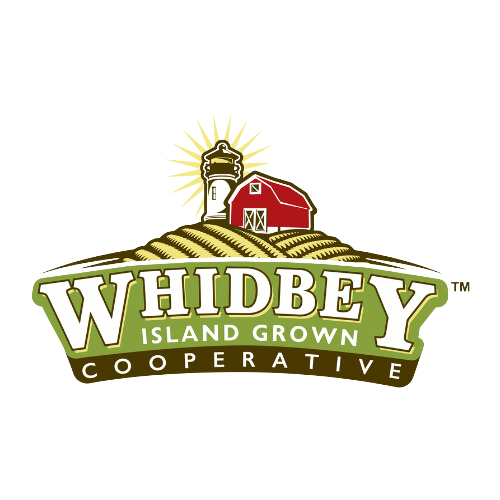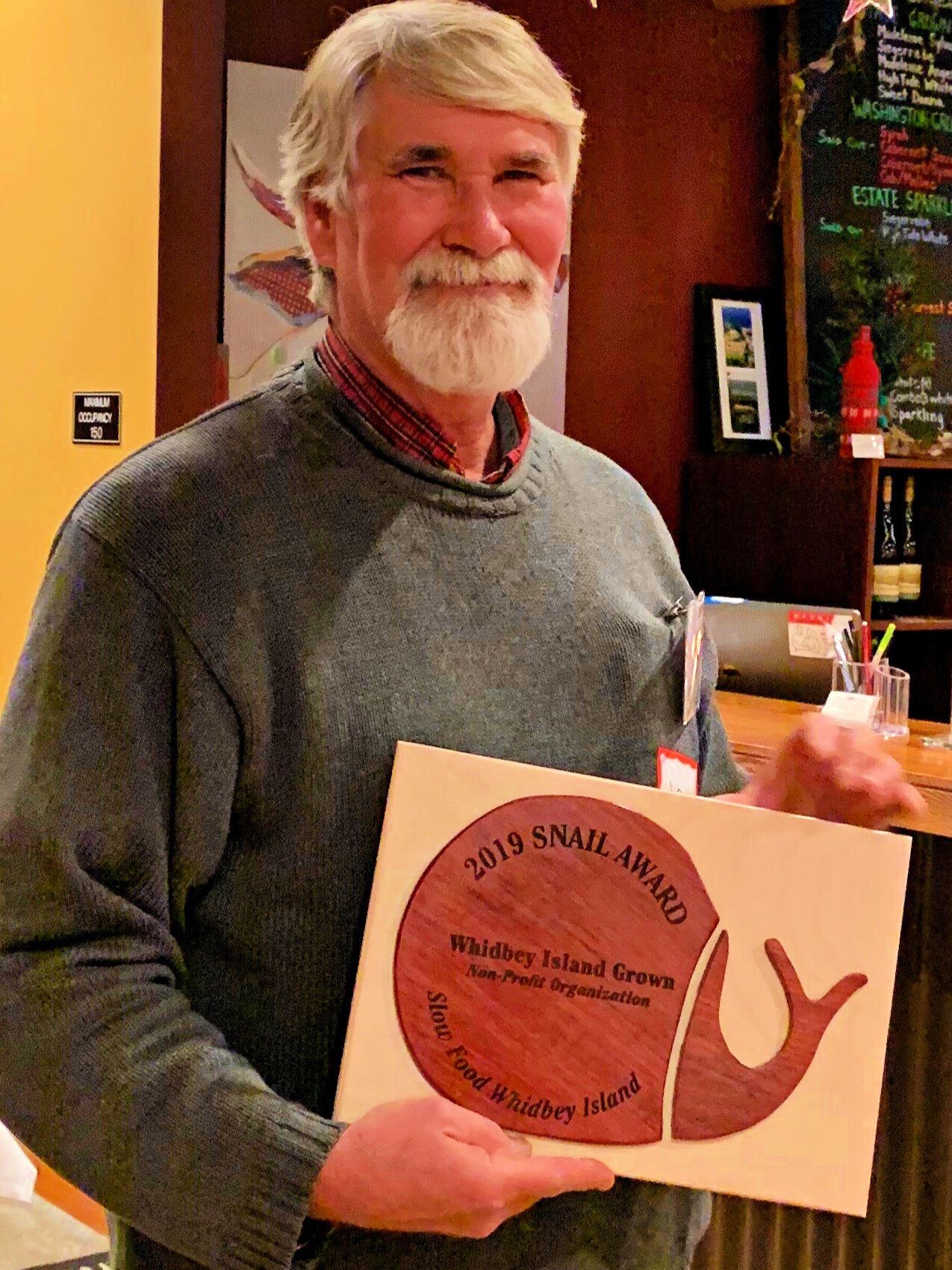Kettle’s Edge Farm
You never know where life will take you, and Kettle’s Edge owner John Burks is proof of that! After retiring in 2007, John planned to grow grapes and start a winery, but the 2008 economic collapse caused him to change his mind and look at growing food. He attended the Organic Farm School, and started his mixed vegetable farm in 2011. John is a storyteller and hard worker who has given a ton of his time to our community through organizations like the Coupeville Lions Club and Whidbey Island Grown.
We asked John a series of questions about his farm and life. Read on to learn more about one of your local producers!
Why do you farm?
When I retired in 2007 my plan was to grow grapes and make wine, but the economic collapse in 2008 and the sheer number of new wineries that were starting up in Washington at the time led me to rethink that plan. I knew that I wanted to do something agriculture related, but really did not have an adequate skill base to begin farming commercially. I learned about the Organic Farm School that was being formed and decided to apply to that program in 2009. The program was a good reality check on how much work would be involved in establishing a commercial farm business, and it took me about a year to get re-energized and launch Kettle’s Edge Farm in 2011. I decided to take that step because I really enjoyed growing vegetables and feeding people. It is that same pleasure that keeps me farming today.
Kettle’s Edge Farming Practices:
I am not certified organic, but I do not use pesticides or herbicides in my production. I try to plant beneficial insect attracting plant varieties and plant cover crops in the fall to protect the soil, fix nitrogen and build organic matter in the spring. I have my cultivated fields divided into sections for the management of crop rotations.
What do you grow?
I have scaled back on the number of different varieties of vegetables that I grow over the past couple of years since I now work closely with Tyler Hansen, chef and owner of Oystercatcher restaurant, to supply them with items that they use in their menus. It is still a good diversity of produce from all the typical brassicas (i.e. broccoli, cabbage, kale), lots of alliums (i.e. onions, garlic), potatoes, snap peas, bush beans, beets, carrots, celeriac, heirloom tomatoes, sweet and hot peppers, eggplant, squash and cucumbers. I also like to grow lots of flowers.
What is your favorite crop to grow and how do you cook it?
Each year poses different challenges and those challenges trigger my interest in figuring out how to do better the next year in producing that crop. Last year I was late getting my tomatoes transplanted and was really late getting fresh tomatoes for harvest. This year I managed to get my starts transplanted six weeks earlier. So, I am hoping for a much earlier harvest.
I grow a lot of peppers, particularly hot peppers for Tyler (at Oystercatcher), who uses them to make his own hot sauces and in other recipes. I like a sweet Italian pepper, Jimmy Nardello. I find these are really great sauteed in fresh olive oil with a bit of sea salt.
Why is community important to your business and your values?
I have been involved with a number of organizations since moving to Whidbey in 2007. I joined the Central Whidbey Lions and have served as president of that club. They do hands-on-projects for the local community and just completed construction of a pack shed for the Coupeville School Farm program. I served on the board of the Organic Farm School for 6 years and represented Whidbey Island on the Northwest Agricultural Business Center (NABC) for 4 years. I worked as a founding member of the Whidbey Island Slow Food chapter and served on that board for 3 years. When I started farming commercially, I joined the Oak Harbor and Coupeville Farmers Markets and served several years on the board of the Coupeville Farmers Market. I very much enjoyed the interaction with the public at the local markets and appreciated the comments that I got from the market shoppers about the quality of our produce. That feedback kept me motivated and reinforced the importance of what I was doing.
You’ve been involved with Whidbey Island Grown since 2011 - how has WIG evolved since then?
I became aware of Whidbey Island Grown shortly after I started my commercial farm operation in 2011, and I joined as a member. The organization was formed with the support of the Northwest Agricultural Business Center. Once grant funding for administrative support ran out, the organization languished for a few years.
Interest in relaunching Whidbey Island Grown grew out of a series of monthly meetings of local farmers, the Whidbey Island Growers’ Association, sponsored by the Whidbey Island Conservation District and led by Karen Bishop in 2016. I agreed to serve as the chair of a steering committee to work on relaunching the organization as a collaborative network of local businesses whose objectives were to preserve and promote Whidbey Island as an authentic rural, farm and culinary destination through taste-driven experiences, products and attractions.
We relaunched the organization in 2017 with lots of help from Sherrye Wyatt and NABC. Sherrye also recruited Elicia (Lee) Fritsch as a volunteer to work with the organization. We grew the organization to over 100 local businesses and individual members over the next two years. As 2019 drew to a close, I knew that I needed to step away from the organization to have more time for other activities. In January of 2020 Kyle Flack and Stephen Williams came to me with their plans to launch a co-operative food hub, and it seemed logical to try to integrate this activity with the existing Whidbey Island Grown brand. Members of the Whidbey Island Grown steering committee agreed with this idea, and the process of integration quickly took place. The food hub launched last May.
How has the food hub impacted your farm?
I decided to begin scaling back my farm production in 2018 to have more time to spend visiting my elderly father who was living in Oklahoma with my sister. I began working closely with Tyler Hansen to provide his restaurant, Oystercatcher, with produce that he uses in his menus. I maintain an e-mail list of customers that have bought from me over the years and last year I started sending out a weekly fresh sheet and taking orders for pickup on Saturdays. I found times that I still had extra produce to sell, and the food hub has provided me a great outlet for that product.
Fun Facts about Farmer John:
Favorite band: The Who - I suppose that this dates me!
Favorite TV show: Masterpiece Theater on PBS
Hobbies outside of farming: I used to play a lot of tennis and was a certified umpire at one time, but I have not played at all since moving to Whidbey. I was very active in road cycling and was a member of the Whidbey Island Bicycle club for a number of years. I managed to ride the Tour de Whidbey in 2012, but I have allowed farming to really take over much of my time.
Favorite spot on the island: I truly love our home location just outside of Coupeville in the heart of Ebey’s Reserve. I find the view from Sunnyside Cemetery over Ebey’s Landing remarkable and enjoy the walk along the bluff trail above the Landing.
You can buy from Kettle’s Edge Farm on the Food Hub and through their email list, which you can get on by emailing John at farmerjohnburks@gmail.com. You can also enjoy Kettle’s Edge produce at Oystercatcher in Coupeville. And check out his video interview on our Youtube channel!




